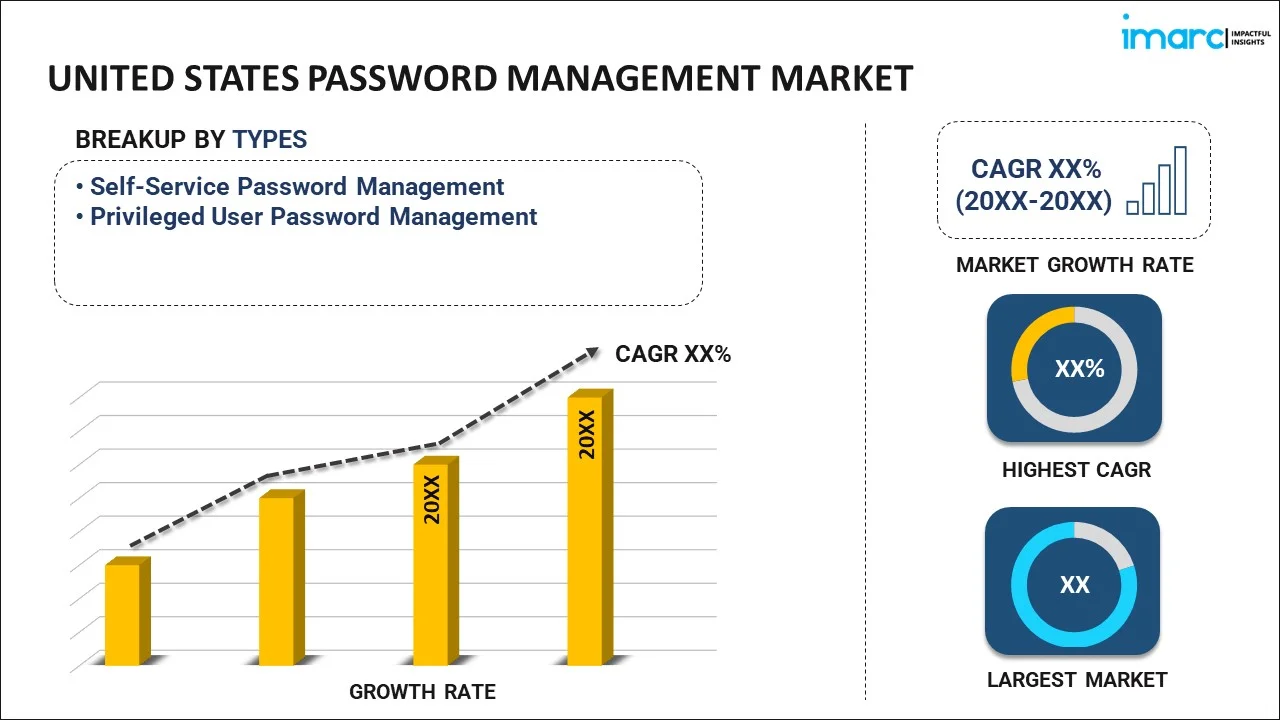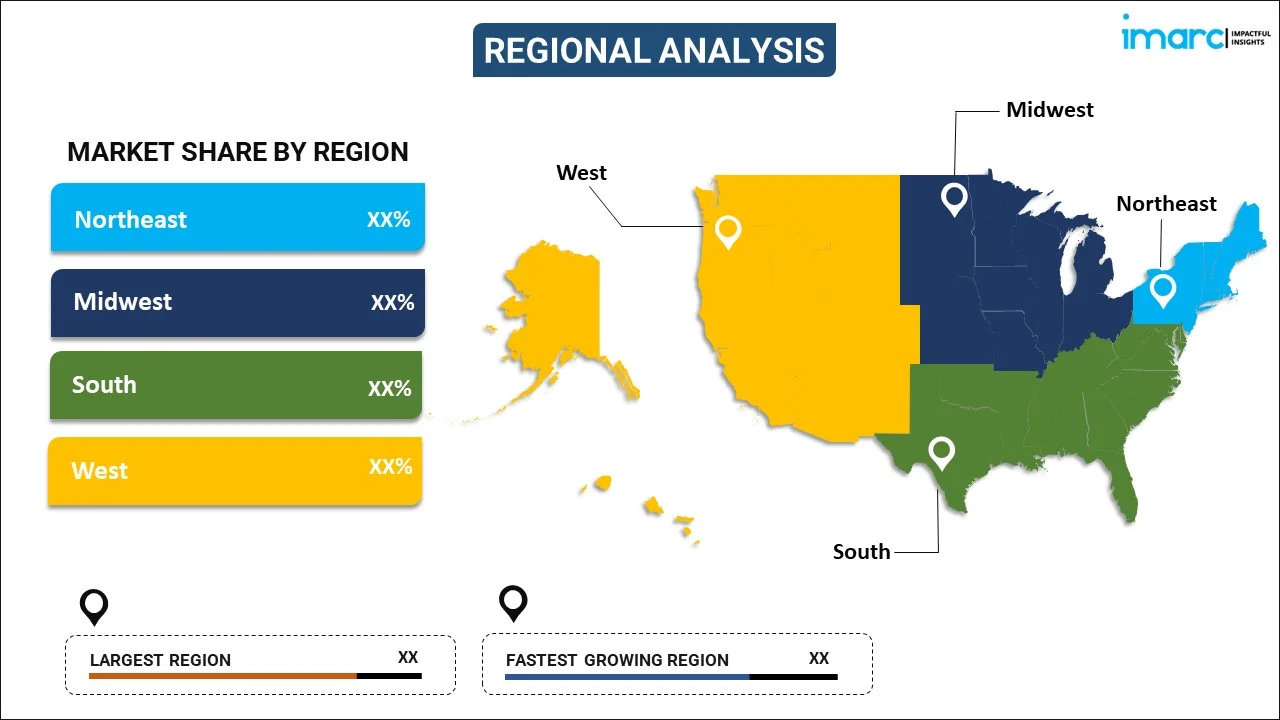
United States Password Management Market Report by Type (Self-Service Password Management, Privileged User Password Management), Access (Mobile Devices and Tablets, Desktop and Laptops, Voice Enabled Password Systems, and Others), Deployment Type (On-premises, Hosted), End User (Small and Medium-sized Organizations, Large Organizations), Vertical (BFSI, Public Sector, IT and Telecom, Retail and Consumer Goods, Education, and Others), and Region 2025-2033
Market Overview:
United States password management market size reached USD 840.1 Million in 2024. Looking forward, IMARC Group expects the market to reach USD 3,783.4 Million by 2033, exhibiting a growth rate (CAGR) of 18.20% during 2025-2033. The escalating demand for advanced systems that are deployed either on-premises or over the cloud, owing to the rising concerns among enterprises towards security breaches, is primarily driving the United States password management market share.
|
Report Attribute
|
Key Statistics
|
|---|---|
|
Base Year
|
2024
|
|
Forecast Years
|
2025-2033
|
|
Historical Years
|
2019-2024
|
|
Market Size in 2024
|
USD 840.1 Million |
|
Market Forecast in 2033
|
USD 3,783.4 Million |
| Market Growth Rate 2025-2033 | 18.20% |
United States Password Management Market Analysis:
- Key Market Trends: Cloud-based password management platforms are picking up substantial momentum in the market landscape. Advanced technology integration such as artificial intelligence and machine learning makes security features more robust. Multi-factor authentication and biometric identification are emerging as standard features, fostering innovation and market competition throughout the region.
- Major Drivers: The United States password management market growth is driven by the heightened cybersecurity threats and growing instances of data breaches. Increased remote work culture demands strong password security solutions. Emerging digital transformation efforts in the enterprise sector and strict regulatory compliance requirements drive market growth nationwide.
- Market Challenges: Customer unwillingness to implement new password management technologies is a major United States password management market demand challenge. Fears over data confidentiality and inherent security risks in centralized password storage architectures give rise to market resistance. Integration complexity with current enterprise infrastructure is an ever-present operational challenge.
- Market Opportunities: Sustained small and medium-sized enterprise (SME) adoption offers significant opportunities for United States password management market analysis. New technologies such as zero-trust security frameworks introduce new market spaces. Enhanced cybersecurity awareness and government campaigns pushing digital security standards provide high growth opportunities for market participants.
Password management generally involves the use of a software tool designed to organize and oversee passwords across servers, network appliances, and computer systems within an IT infrastructure. It serves as a crucial asset for information security and governance, encouraging end users to conduct audits, secure, manage, and monitor activities related to privileged accounts. While commonly employed by enterprises, these software systems are also utilized by individuals seeking enhanced security measures. Their primary function is to safeguard against cyber threats, ensuring the protection of sensitive data, files, financial records, legal information, etc.
United States Password Management Market Trends:
Enhanced Artificial Intelligence Integration
Password management tools more and more feature advanced artificial intelligence and machine learning technology that makes security procedures and user interfaces better. AI-based features consist of intelligent threat detection, abnormal behavior analysis, and predictive security notifications that anticipate potential invasions in advance. These advanced solutions can automatically create complex passwords with respect to particular security needs, review password power in real-time, and give individualized security suggestions to users. Machine learning ability allows security algorithms to be constantly upgraded by learning user behavior patterns as well as developing new threat profiles. AI-powered password managers can also identify hacked passwords on the dark web and notify users on the spot. The integration also applies to automated password rotation plans, minimizing manual input while preserving optimal security measures. This technological innovation significantly lessens the load on IT departments while providing enterprise-level security at all organizational levels, thus making AI integration an essential differentiator for the password management competitive landscape.
Zero-Trust Security Architecture Adoption
The move to zero-trust security paradigms is inherently revolutionizing password management approaches in United States businesses. Such a model assumes no inherent trust and invokes authentication for all users, devices, and applications trying to reach company resources. Password management tools are changing to accommodate zero-trust philosophies by adopting continuous authentication methods, context-based access controls, and dynamic risk adjustment functionality. These systems now enable granular visibility of user access patterns, which helps organizations to identify and respond to suspicious behavior in real-time. Integration with identity and access management platforms will allow seamless user experience with strict security controls in place. Zero-trust compatible password managers also facilitate privileged access management, which makes administrative credentials receive extra protection and monitoring. This design methodology greatly minimizes the attack surface by removing implicit trust relationships and demanding explicit verification at each point of access, fueling widespread adoption among security-aware organizations that require end-to-end protection against advanced cyber threats.
Multi-Modal Authentication Evolution
Password management solutions are moving at great speed from conventional password-based security towards the integration of end-to-end multi-modal authentication systems. These next-gen solutions use a variety of verification factors such as biometric authentication (fingerprint, facial recognition, voice patterns), behavior biometrics (typical typing patterns, movement of the mouse), and contextual factors (location, device features, time-based access patterns). The addition of hardware security keys along with mobile device-based authentication offers extra layers of security without compromising on user convenience. Current password managers also accommodate effortless integration with multiple authentication schemes such as SAML, OAuth, and OpenID Connect to support flexibility within mixed-up enterprise environments. In addition, adaptive authentication features modify security needs in line with risk evaluation by demanding more intense authentication for high-risk situations while optimizing access for everyday activities. This progress handles increasing fears of password susceptibility as well as catering to the needs of users for easy, secure access. The direction toward passwordless authentication is the way forward, with password managers being bridge technologies en route to wholly password-free security designs.
United States Password Management Market Segmentation:
IMARC Group provides an analysis of the key trends in each segment of the market, along with forecasts at the country level for 2025-2033. Our report has categorized the market based on type, access, deployment type, end user, and vertical.
Type Insights:

To get more information on this market, Request Sample
- Self-Service Password Management
- Privileged User Password Management
The report has provided a detailed breakup and analysis of the market based on the type. This includes self-service password management and privileged user password management.
Access Insights:
- Mobile Devices and Tablets
- Desktop and Laptops
- Voice Enabled Password Systems
- Others
A detailed breakup and analysis of the market based on the access have also been provided in the report. This includes mobile devices and tablets, desktop and laptops, voice enabled password systems, and others.
Deployment Type Insights:
- On-premises
- Hosted
The report has provided a detailed breakup and analysis of the market based on the deployment type. This includes on-premises and hosted.
End User Insights:
- Small and Medium-sized Organizations
- Large Organizations
A detailed breakup and analysis of the market based on the end user have also been provided in the report. This includes small and medium-sized organizations and large organizations.
Vertical Insights:
- Healthcare
- BFSI
- Public Sector
- IT and Telecom
- Retail and Consumer Goods
- Education
- Others
The report has provided a detailed breakup and analysis of the market based on the vertical. This includes Healthcare, BFSI, public sector, IT and telecom, retail and consumer goods, education, and others.
Regional Insights:

- Northeast
- Midwest
- South
- West
The report has also provided a comprehensive analysis of all the major regional markets, which include Northeast, Midwest, South, and West.
Competitive Landscape:
The market research report has also provided a comprehensive analysis of the competitive landscape in the market. Competitive analysis such as market structure, key player positioning, top winning strategies, competitive dashboard, and company evaluation quadrant has been covered in the report. Also, detailed profiles of all major companies have been provided.
Recent News and Development:
- In August 2025, LastPass launched passkey support, enabling users and businesses to securely log in across devices, browsers, and operating systems. Passkeys can now be created, stored, and managed alongside passwords in the LastPass vault, enhancing security and reducing phishing risks. The feature offers cross-platform access, encryption-protected credentials, and simplified management, helping IT teams improve security posture, streamline user adoption, and reduce helpdesk workload while moving beyond traditional password-based authentication.
United States Password Management Market Report Coverage:
| Report Features | Details |
|---|---|
| Base Year of the Analysis | 2024 |
| Historical Period | 2019-2024 |
| Forecast Period | 2025-2033 |
| Units | Million USD |
| Scope of the Report | Exploration of Historical Trends and Market Outlook, Industry Catalysts and Challenges, Segment-Wise Historical and Future Market Assessment:
|
| Types Covered | Self-Service Password Management, Privileged User Password Management |
| Access Covered | Mobile Devices and Tablets, Desktop and Laptops, Voice Enabled Password Systems, Others |
| Deployment Types Covered | On-premises, Hosted |
| End Users Covered | Small and Medium-sized Organizations, Large Organizations |
| Verticals Covered | BFSI, Public Sector, IT and Telecom, Retail and Consumer Goods, Education, Others |
| Regions Covered | Northeast, Midwest, South, West |
| Customization Scope | 10% Free Customization |
| Post-Sale Analyst Support | 10-12 Weeks |
| Delivery Format | PDF and Excel through Email (We can also provide the editable version of the report in PPT/Word format on special request) |
Key Benefits for Stakeholders:
- IMARC’s industry report offers a comprehensive quantitative analysis of various market segments, historical and current market trends, market forecasts, and dynamics of the United States password management market from 2019-2033.
- The research report provides the latest information on the market drivers, challenges, and opportunities in the United States password management market.
- Porter's five forces analysis assist stakeholders in assessing the impact of new entrants, competitive rivalry, supplier power, buyer power, and the threat of substitution. It helps stakeholders to analyze the level of competition within the United States password management industry and its attractiveness.
- Competitive landscape allows stakeholders to understand their competitive environment and provides an insight into the current positions of key players in the market.
Key Questions Answered in This Report
The password management market in the United States was valued at USD 840.1 Million in 2024.
The United States password management market is projected to exhibit a CAGR of 18.20% during 2025-2033, reaching a value of USD 3,783.4 Million by 2033.
The escalating demand for advanced systems deployed on-premises or over cloud platforms drives market growth. Rising enterprise security breach concerns, increasing digital transformation initiatives, regulatory compliance requirements, remote work culture adoption, and growing cybersecurity awareness among organizations are the primary factors propelling market expansion across the United States.
Need more help?
- Speak to our experienced analysts for insights on the current market scenarios.
- Include additional segments and countries to customize the report as per your requirement.
- Gain an unparalleled competitive advantage in your domain by understanding how to utilize the report and positively impacting your operations and revenue.
- For further assistance, please connect with our analysts.
 Request Customization
Request Customization
 Speak to an Analyst
Speak to an Analyst
 Request Brochure
Request Brochure
 Inquire Before Buying
Inquire Before Buying




.webp)




.webp)












